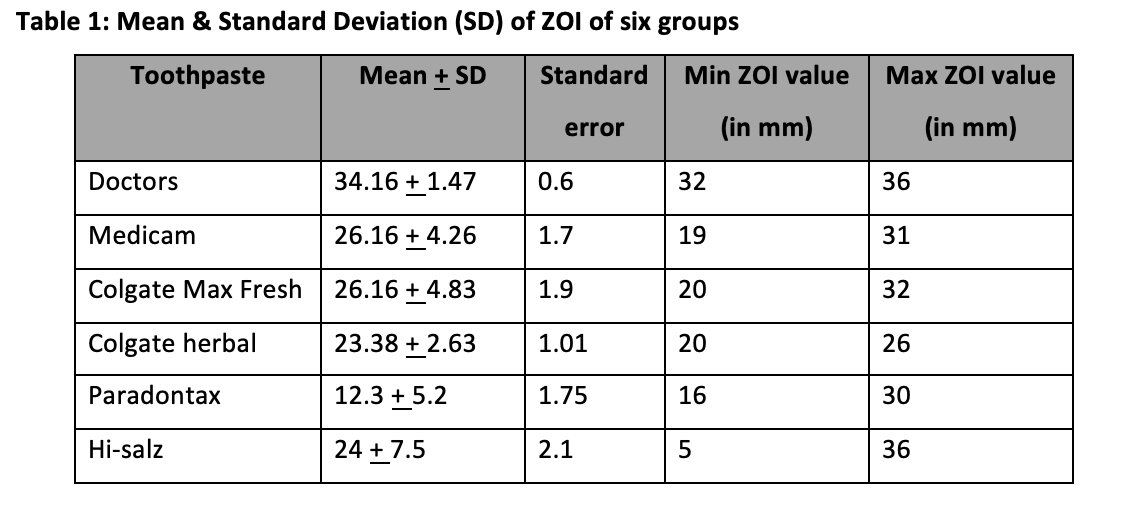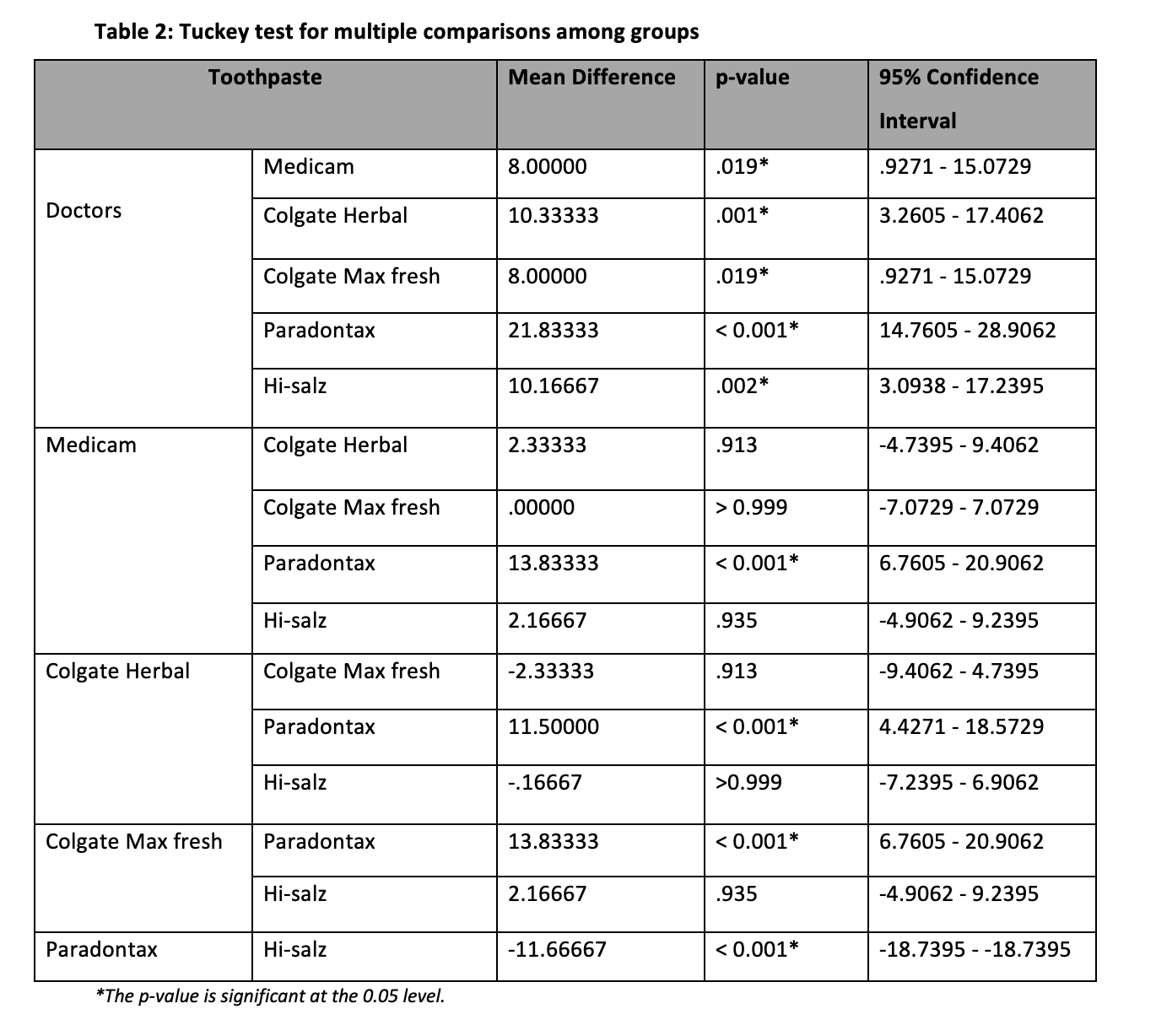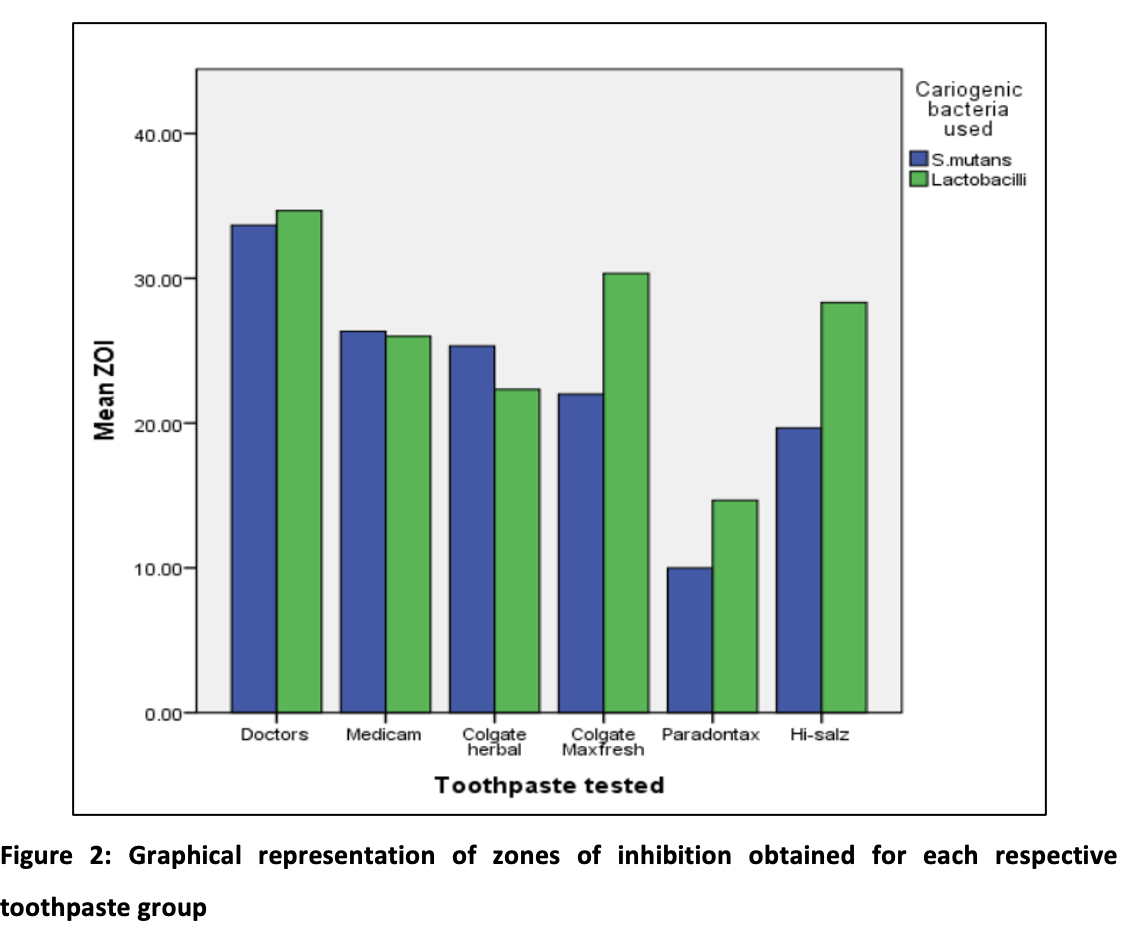By Memuna Kausar Satti1, Farwa Rais2, Zainab Qasim3, Zuleikha Malik4, Maryam Maqsood3, Kunza Naveed Asdaq5
- 1Dental Materials Department, Rawal Institute of Health Sciences, Rawalpindi, Pakistan
- Dental Materials Department, Islamabad Medical and Dental College, Islamabad, Pakistan
- Dental Materials Department, Army Medical College, Rawalpindi, Pakistan
- Hitec Medical and Dental College, Taxilla, Pakistan
- 5Dental Materials Department, Margalla Institute of Health Sciences, Rawalpindi, Pakistan
DOI: https://doi.org/10.36283/PJMD12-4/009
How to cite: Satti MK, Rais F, Qasim Z, Malik Z, Maqsood M, Asdaq KN. A Comparative Antimicrobial Analysis of Commercially Available Toothpaste; An In-Vitro Study. Pak J Med Dent. 2023;12(4): 45-50. Doi: 10.36283/PJMD12-4/009
Background: The incorporation of certain antimicrobial materials is an effective way to prevent early carious lesions. The additive effect of improving hygiene habits and using antimicrobial toothpaste for brushing can lead to the prevention of tooth decay. This study aimed to check the anti-cariogenic activity against Streptococcus mutants and Lactobacillus. acidophilus of six commercially available toothpaste using the Agar well diffusion method.
Methods: The antimicrobial efficacy of different dentifrices was determined using the modified agar well diffusion method. Each dentifrice was separately plated in triplicates and the experiment was repeated thrice. Agar plates were inoculated with 20uL of 24h broth cultures of each bacterial isolate, 0.2mL of the respective dentifrice was introduced into each of the three wells and distilled water was introduced into the last well as control. The plates were incubated at 37 o C for 48 hours. Statistical analysis was done using the statistical package, SPSS, by applying one-way ANOVA and post-hoc Tuckey test.
Results: All the experimental toothpaste groups being tested in this study presented antimicrobial activity against both bacterial pathogens, however, each differed in its efficacy. Comparison between different groups displayed significant results (p-value < 0.001). Among all the groups, Doctor’s toothpaste showed the highest antimicrobial activity (Mean + SD) (34.16 +1.47) against S. mutans whereas the Paradontax showed the minimalist antimicrobial activity (12.3 + 5.2).
Conclusion: Doctors’ toothpaste showed the best anti-bacterial effect against both bacteria, while Paradontax showed the least activity.
Keywords: Cariogenic Agents, Toothpaste, Disk Diffusion Antimicrobial Tests.
In many developing countries, many dental problems are due to microbial infection 1. Oral Health of an individual correlates directly to a person’s general well-being 2. Dental caries is regarded as a localized infectious process that leads to the destruction of the dental hard tissue. It is initiated by the build-up of dental plaque3. Dental caries has a complex etiology and deals with loss of tooth structure owing to acids produced by certain bacteria 4. Streptococcus mutants (S. mutants) have been considered as the main culprit behind enamel dissolution along with Lactobacillus acidophilus (L. acidophilus) being involved in dentin decay 5.
The process of cavity formation is a preventable condition, nonetheless still prevalent in numerous developing countries due to insufficient awareness regarding oral hygiene maintenance. If left untreated, cariogenic activity aggravates and can lead to serious implications such as pain and sensitivity 5,6. In various individuals, the customary method of oral hygiene maintenance which is tooth brushing, is usually not sufficient to provide a consistent level of plaque control 7. Consequently, antimicrobial or antibacterial agents are incorporated as a mean of potential prophylactic method of reducing plaque-mediated disease. Their use may help in reducing the levels of oral bacteria, specifically Streptococcus mutans6,8.
Generally, toothpaste contains 20 to 40% water and 50% abrasives that include aluminum hydroxide, calcium hydrogen phosphate, calcium carbonate, silica, and hydroxyapatite 9,10. The content of fluoride is up to 1450ppm which is mainly in the form of sodium fluoride. Triclosan is used as an antibacterial agent conventionally, however, fluoride can also impart antibacterial action. Frequently the toothpastes available in the market contain fluoride and cleansers 11. The incorporation of certain antimicrobial materials is an effective way to prevent early carious lesions. Some of these toothpastes claim to be anti-cavity and enhance the repair process as well. The additive effect of improving hygiene habits and using antimicrobial toothpaste for brushing can lead to the prevention of tooth decay 12.
Triclosan is regarded as a low-toxicity, non-ionic phenolic derivative with a wide spectrum of antimicrobial activity. It has been successfully incorporated into toothpaste and mouth rinses, resulting in moderate but distinct positive effects on both dental biofilm and marginal inflammation or gingivitis 13. The evidence indicates that the ingredients in the formula of triclosan-containing mouthwashes, including vehicle and other active substances, may influence its antimicrobial activity, and consequently its clinical efficiency 14. At present triclosan is the active ingredient in many oral hygiene formulations due to its ability to block the synthesis of fatty acids by inhibiting the enoyl-acyl carrier protein reductase enzyme 15.
Dentifrices need to contain various antimicrobial agents to reduce, control, and prevent different kinds of dental diseases. Many dentifrices claim to have antimicrobial properties but very little research has been conducted to investigate these claims. Based on this scanty information, the present study was designed 1,16. This study aimed to check the anti-cariogenic activity against S. mutans and L. acidophilus of six commercially available toothpaste using the Agar well diffusion method. Zones of inhibitions were measured to assess the efficacy of these toothpastes against two of the major cariogenic pathogens.
Pure cultures of streptococcus mutans ATCC no. 25175 and Lactobacillus acidophilus ATCC no. 4356 were purchased from Oxoid company. Cultures of S. mutans and L. acidophilus were obtained in dehydrated form and after rehydration, were cultured in BHI broth for 24 hours at 37 °C.
Six toothpaste brands were randomly selected based on their popularity of use within our general population. They were purchased from a local pharmacy. The selected dentifrices were used in a specific amount (2 gm), as recommended by general dental surgeons for daily use. Mueller-Hilton agar plates were prepared separately to assess the antimicrobial efficacy of dentifrices against these pathogens. All of the other regents and chemicals employed were of analytical grade. The ethical approval was obtained from Dental College, Hitech, IMS with the reference number REF: Dental/HITEC/IRB/35.
The antimicrobial efficacy of different dentifrices was determined using the modified agar well diffusion method. Each dentifrice was separately plated in triplicates and the experiment was repeated thrice. In this test, MH agar plates were inoculated with 20uL of 24h broth cultures of each bacterial isolate and spread uniformly. Then these plates were allowed to dry for 1 hour. Using a sterile 4mm cork-borer, one central and three wells equally distanced were cut in each of the plates. 0.2mL of the respective dentifrice was introduced into each of the three wells, while the same amount of distilled water was introduced into the last well as a control. The plates were incubated at 37 °C for 48 hours (an anaerobic jar was used for the growth of S. mutans).
Statistical analysis was done using the statistical package, SPSS IBM Chicago, USA version 22, by applying one-way ANOVA and post-hoc Tuckey test. Results are presented in the form of charts and tables. A p-value less than and equal to 0.05 was considered statistically significant.
All the experimental toothpaste groups being tested in this study presented antimicrobial activity against both bacterial pathogens, however, each differed in its efficacy. The antimicrobial activity was evaluated by measuring the zones of inhibition (mm). The mean values and standard deviation of zones of inhibition (ZOI) of all the toothpaste are tabulated in Table 1.

Significant values (p=0.00) between the groups were analyzed by ANOVA. It can be inferred that comparisons between different groups displayed significant results. Among all the groups, Doctor’s toothpaste showed the highest antimicrobial activity against S. mutans whereas the Paradontax showed the minimalist antimicrobial activity. Tukey test values for the multiple comparisons are shown in Table 2.

The diameters of the zones of inhibition obtained against S. mutans were as follows: Doctors’ toothpaste showed a significantly higher efficacy compared to all other toothpaste being tested, followed by Medicam toothpaste, while Colgate Maxfresh and Colgate Herbal exhibited almost the same results with a slight difference in comparison to each other. Against L. acidophilus the highest antimicrobial activity was shown again by doctors’ toothpaste whereas the lowest antimicrobial activity was observed for Parodontax. While the other groups exhibited average anti-bacterial action as seen in the graphical figure 2.

The most encountered oral condition in human beings is dental caries, caused by the accumulation of dental plaque which harbors a wide variety of pathogens including Streptococcus mutans and lactobacillus acidophilus 17. These are considered the predominant cariogenic contributors to the tooth structure demineralization and decay, initially involving enamel and ultimately the deeper structures i.e., dentine and pulp. Maintenance of effective and efficient oral hygiene is the key to preventing this disastrous cascade of events18. Mechanical cleaning of teeth must be supplemented with a good dentifrice. In Pakistan, a long list of toothpaste is available commercially with variable compositions, but the focus of this study was to determine the antimicrobial efficacy of six commonly used local brands of tubes of toothpaste 19.
In the present study, antibacterial activity was tested against the two most common caries-causing microorganisms i.e., Streptococcus mutants and lactobacillus using a well diffusion method. Statistical analysis was done using SPSS to compare the activity of local brands with each other as done in a study by Rossi et al. 2014. According to the results obtained after 48 hours, Doctors toothpaste showed the maximum zone of inhibition i.e., 33.6 mm for S. mutans and 34.6mm for lactobacilli whereas minimum zones were recorded for parodontex. Colgate Maxfresh showed greater antimicrobial activity against Acidophilus as compared to S. mutans. It can be inferred from the composition provided by the manufacturer on the box that Doctors toothpaste has multiple constituents with antimicrobial activity, responsible for the above-mentioned results. Amongst these Potassium citrate, Chlorhexidine Di gluconate, sodium monoflouraphosphate, and polyethylene glycol are the primary contributors. According to Lee et al., potassium citrate inhibits bacterial growth in the same way. Verkaik et al. stated that chlorhexidine exhibits its activity by disrupting of cell membrane resulting in cell death 20. Polyethylene glycol causes clumping and alteration in bacterial morphology by creating a net water deficit in the cell and monoflouraphosphate stops Polysaccharide synthesis in S. mutans. As stated, earlier Paradontax did not show a significant zone of inhibition against the two bacteria under study which is in contrast to the findings of Rossi et al., where it was found to be active against S. mutans. The active ingredient mentioned on the packaging was sodium fluoride which is primarily a source of fluoride displaying a bacteriostatic effect instead of a bactericidal one 21.
As shown in the graph the disparity in the activity of Doctors and Paradontax toothpaste can be attributed to the difference in their compositions. Medicam, Colgate Herbal, Colgate Maxfresh, and Hi Salz did not show a statistically significant difference in their activity. The addition of herbal products such as clove oil, menthol, and eucalyptus provide a synergistic antimicrobial result. Sorbitol was found in four out of six toothpastes under experimentation, which contributes to the anti-caries effect by acting as a slower fermenting substrate 22.
It is suggested that the qualitative and quantitative compositions of the dentifrices should be listed on the commercial pack for the consumer’s information. The experiment performed was an in-vitro study, which did not take into consideration the effect of salivary dilution, intra-oral PH, and dietary habits. Another limitation was the use of only two species of bacteria present within the biofilm, although multiple other pathogens are involved in the process of dental caries. Considering that this study was conducted to assess the anti-cavity effect of our daily use of toothpaste, the results of this study point towards positive anti-cavity effects of Doctors toothpaste in specific thus recommending its use, however, based on our research and assessment, we would recommend Colgate Max fresh and Colgate Herbal toothpaste to be used for daily routines, since the chemical composition of Doctors toothpaste being exceedingly effective, oral microflora is highly susceptible to alterations in response to exposure of such strong chemicals daily. Hence, Doctors’ toothpaste should be considered as an efficient medicated toothpaste, used for a maximum of 2 weeks as per requirements.
This in-vitro experiment assessed that Doctors toothpaste showed the best anti-bacterial effect against S. mutans and L. acidophilus with significant results, while Paradontax showed the least activity. However, it was recommended that Colgate Max fresh and Colgate herbal toothpaste must be used for daily routine usage as both of these denitrifies showed moderate anti-bacterial effects along with their modest composition, suggesting their minimal effects on general oral microflora and good activity against pathogenic oral microflora.
We acknowledge Hitech Medical and Dental College, Army Medical College, and Dr. Saba Waqar for the required support and for providing assistance and supervision.
There is no conflict of interest among authors.
Ethical approval for the conduction of the study was obtained from Dental College, Hitech, IMS with the reference number REF: Dental/HITEC/IRB/35.
MKS: Correspondence and article arrangement. FR: Introduction and conclusion writing. ZQB: Results writing. ZM: Practical work and methodology writing. MM: discussion writing. KNA: Results analysis and driving of conclusions.
- Junevičius J, Žilinskas J, Česaitis K, Česaitienė G, Gleiznys D, Maželienė Ž. Antimicrobial activity of silver and gold in toothpaste: A comparative analysis. Stomatologija. 2015;17(1):9-12.
- Duong HY, Roccuzzo A, Stähli A, Salvi GE, Lang NP, Sculean A. Oral health-related quality of life of patients rehabilitated with fixed and removable implant-supported dental prostheses. Periodontol 2000. 2022 Feb;88(1):201-237. doi: 10.1111/prd.12419.
- Cheng L, Zhang L, Yue L, Ling J, Fan M, Yang D, Huang Z, Niu Y, Liu J, Zhao J, Li Y, Guo B, Chen Z, Zhou X. Expert consensus on dental caries management. Int J Oral Sci. 2022 Mar 31;14(1):17. doi: 10.1038/s41368-022-00167-3.
- Rathee M, Sapra A. Dental caries. 2019. PMID: 31869163.
- Nyvad B, Takahashi N. Integrated hypothesis of dental caries and periodontal diseases. J Oral Microbiol. 2020 Jan 7;12(1):1710953. doi: 10.1080/20002297.2019.1710953.
- Chen R, Santo K, Wong G, Sohn W, Spallek H, Chow C, et al. Mobile apps for dental caries prevention: systematic search and quality evaluation. JMIR mHealth and uHealth. 2021;9(1):e19958. doi: 10.2196/19958.
- Javed S, Zakirulla M, Baig RU, Asif S, Meer AB. Development of artificial neural network model for prediction of post-streptococcus mutans in dental caries. Computer Methods and Programs in Biomedicine. 2020;186:105198. doi: 10.1016/j.cmpb.2019.105198.
- Rezaei T, Mehramouz B, Gholizadeh P, Yousefi L, Ganbarov K, Ghotaslou R, et al. Factors associated with Streptococcus mutans pathogenicity in the oral cavity. Biointerface Res Appl Chem. 2023;13(4):368. https://doi.org/10.33263/BRIAC134.368
- Muntean A, Sava S, Delean AG, Mihailescu AM, Dumitrescu LS, Moldovan M, et al. Toothpaste composition effect on enamel chromatic and morphological characteristics: In vitro analysis. Materials. 2019;12(16):2610. doi: 10.3390/ma12162610.
- de Moraes Rego Roselino L, Tonani Torrieri R, Sbardelotto C, Alves Amorim A, Noronha Ferraz de Arruda C, Tirapelli C, et al. Color stability and surface roughness of composite resins submitted to brushing with bleaching toothpaste: An in situ study. Journal of Esthetic and Restorative Dentistry. 2019;31(5):486-492. doi: 10.1111/jerd.12495.
- Martu M-A, Stoleriu S, Pasarin L, Tudorancea D, Sioustis I-A, Taraboanta I, et al. Toothpaste Composition And Their Role In Oral Cavity Hygiene. Romanian Journal of Medical and Dental Education. 2021;10(3).
- Lima LC, Carvalho AO, Bezerra SJC, Garcia RM, Caneppele TMF, Borges AB, et al. Tooth color change promoted by different whitening toothpastes under alternate cycles of staining and brushing. Journal of Dentistry. 2023;132:104498. doi: 10.1016/j.jdent.2023.
- Anders B, Doll S, Spangenberg B. A validated quantification of triclosan in toothpaste using high-performance thin-layer chromatography and a 48-bit flatbed scanner. JPC–Journal of Planar Chromatography–Modern TLC. 2021;34(3):203-209. https://doi.org/10.1007/s00764-021-00108-6
- Monteiro MF, Tonelli H, Reis AA, Casati MZ, Silvério KG, Nociti Junior FH, et al. Triclosan toothpaste as an adjunct therapy to plaque control in children from periodontitis families: a crossover clinical trial. Clinical oral investigations. 2020;24:1421-1430. doi: 10.1007/s00784-019-03121-6.
- Sinicropi MS, Iacopetta D, Ceramella J, Catalano A, Mariconda A, Pellegrino M, et al. Triclosan: A small molecule with controversial roles. Antibiotics. 2022;11(6):735. DOI: 10.3390/antibiotics11060735
- Rajendiran M, Trivedi HM, Chen D, Gajendrareddy P, Chen L. Recent development of active ingredients in mouthwashes and toothpastes for periodontal diseases. Molecules. 2021;26(7):2001. doi: 10.3390/molecules26072001.
- Chen X, Daliri EB-M, Kim N, Kim J-R, Yoo D, Oh D-H. Microbial etiology and prevention of dental caries: exploiting natural products to inhibit cariogenic biofilms. Pathogens. 2020;9(7):569. doi: 10.3390/pathogens9070569.
- Anil S, Porwal P, Porwal A. Transforming Dental Caries Diagnosis Through Artificial Intelligence-Based Techniques. Cureus. 2023;15(7). doi: 10.7759/cureus.41694.
- Baik A, Alamoudi N, El-Housseiny A, Altuwirqi A. Fluoride varnishes for preventing occlusal dental caries: A review. Dentistry journal. 2021;9(6):64. doi: 10.3390/dj9060064.
- Paqué PN, Karygianni L, Kneubuehler J, Fiscalini L, Wiedemeier DB, Müller M, et al. Microbial approaches for the assessment of toothpaste efficacy against oral species: A method comparison. MicrobiologyOpen. 2022;11(2):e1271. doi: 10.1002/mbo3.1271
- Marinho VT, Dos Reis AC, da Costa Valente ML. Efficacy of Antimicrobial Agents in Dentifrices: A Systematic Review. Antibiotics. 2022;11(10):1413. DOI: 10.3390/antibiotics11101413
- de Oliveira Carvalho I, Purgato GA, Píccolo MS, Pizziolo VR, Coelho RR, Diaz-Muñoz G, et al. In vitro anticariogenic and antibiofilm activities of toothpastes formulated with essential oils. Archives of Oral Biology. 2020;117:104834. DOI: 10.1016/j.archoralbio.2020.104834
This is an open-access article distributed under the terms of the CreativeCommons Attribution License (CC BY) 4.0 https://creativecommons.org/licenses/by/4.0/
